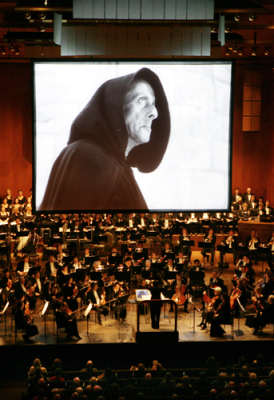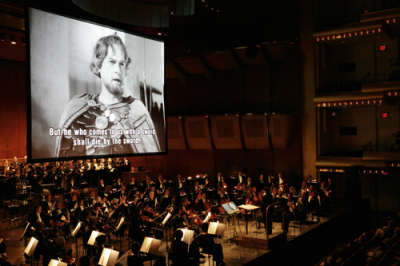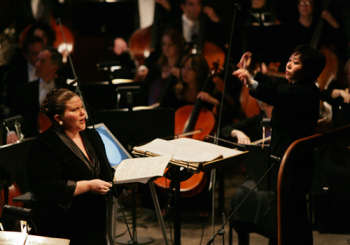|
Editorial Board
Melanie
Eskenazi
Webmaster: Len Mullenger
|
Seen and Heard International Concert Review
Until
this evening I had not seen Sergei Eisenstein’s Alexander
Nevsky combined with the Prokofiev score, and the
effect is quite different from hearing Prokofiev’s stand-alone
cantata version with which most people are familiar.
With fewer breaks, the cantata has the aural sweep of
a tone poem, rather than the ebb and surge of the film,
about half of which has no musical accompaniment at all. For
those unfamiliar with Eisenstein’s masterpiece, it depicts
Alexander Nevsky rousing his people to action and ultimately
leading them to victory over an invasion by the Knights
of the Teutonic Order. The film’s power is matched
by Eisenstein’s keen eye, with images that often are indelibly
etched in viewers’ minds. Many are downright scary,
such as Eisenstein’s surreal costumes. The hooded
Knights, in white robes with crosses, evoke Klansmen,
and their helmets are a bit unnerving, topped with the
claw of a bird, a set of twisted horns, or a human hand.
Other scenes, such as the ravaging of the town of Pskov,
show soldiers executing citizens and tossing small children
onto a fire. At the climax of the battle, the Germans
are backed onto an ice floe that cracks and melts, so
their heavy armor causes them to sink, thrashing to their
deaths in the water. One
of the evening’s finest moments came in the penultimate
section, “The Field of the Dead,” when mezzo-soprano Meredith
Arwady stood to deliver a sorrowful song depicting her
anguished search for the two men vying for her hand in
marriage. Although her moment was brief, her pure
voice (again, quite Russian-sounding) poured into the
hall with impressive passion and loneliness.
Photographs ©
Chris Lee
Back to the Top Back to the Index Page |
| ||
|
||||





